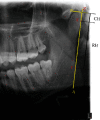Skeletal Divergence and Condylar Asymmetry in Patients with Temporomandibular Disorders (TMD): A Retrospective Study
- PMID: 34608439
- PMCID: PMC8487372
- DOI: 10.1155/2021/8042910
Skeletal Divergence and Condylar Asymmetry in Patients with Temporomandibular Disorders (TMD): A Retrospective Study
Abstract
Introduction: This study was aimed at evaluating the association between vertical skeletal patterns, condylar height symmetry, and temporomandibular disorders in adults.
Methods: The study sample consisted of 200 patients (ages 18-30 years old) retrospectively recruited: 100 with temporomandibular disorders (TMD) and 100 without TMD (control), diagnosed by Diagnostic Criteria for the Temporomandibular Disorders (DC/TMD). For each subject, skeletal divergence was assessed on lateral cephalograms, and condylar height symmetry was evaluated by orthopantomography (Habets' method).
Results: Subjects with temporomandibular disorders showed a strong association with condylar asymmetry (p < 0.0001) and, for the skeletal pattern variables, hyperdivergence (p < 0.001). A correlation with the female sex was also found (p < 0.04), while there was no difference in terms of age in the 2 groups (p > 0.29).
Conclusions: Although it does not imply a direct cause-and-effect relationship, the present study suggests condylar asymmetry and hyperdivergent skeletal pattern are more likely to be associated with a higher risk of temporomandibular disorder joint diseases in adult patients.
Copyright © 2021 Maria Francesca Sfondrini et al.
Conflict of interest statement
The authors declare that they have no conflicts of interest.
Figures





References
-
- Sebbar M., Abidine Z., Laslami N., Bentahar Z. Emerging trends in oral health sciences and dentistry. Periodontal health and orthodontics . IntechOpen; 2015.
-
- Nilner M., Lassing S. A. Prevalence of functional disturbances and diseases of the stomatognathic system in 7-14 year olds. Swedish Dental Journal . 1981;5(5-6):173–187. - PubMed
-
- Manfredini D., Guarda-Nardini L., Winocur E., Piccotti F., Ahlberg J., Lobbezoo F. Research diagnostic criteria for temporomandibular disorders: a systematic review of axis I epidemiologic findings. Oral Surgery, Oral Medicine, Oral Pathology, Oral Radiology, and Endodontology. . 2011;112(4):453–462. doi: 10.1016/j.tripleo.2011.04.021. - DOI - PubMed
-
- Leresche L., Drangsholt M. Epidemiology of orofacial pain: prevalence, incidence, and risk factors. In: Sessle B. J., Lavigne G. J., Lund J. P., Dubner R., editors. Orofacial Pain. From Basic Science to Clinical Management . 2nd ed. Chicago: Quintessence Publishing; 2008. pp. 13–18.
MeSH terms
LinkOut - more resources
Full Text Sources
Medical

